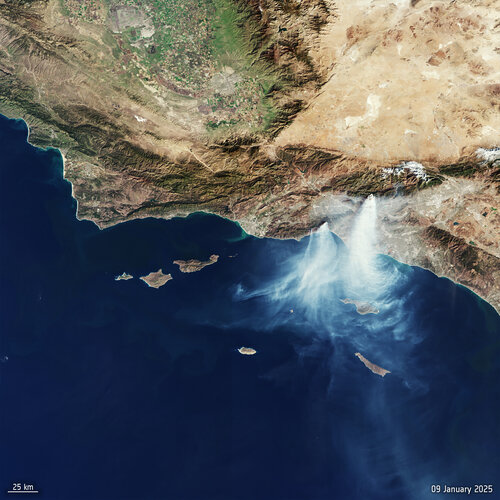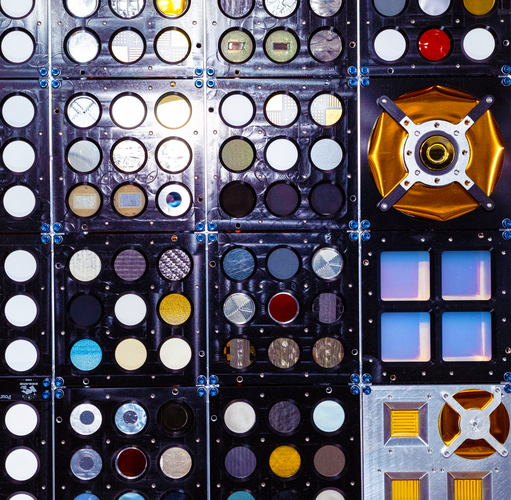NASA instrument on Firefly's Blue Ghost Lander to study lunar interior
Friday, 10 January 2025 15:11This request seems a bit unusual, so we need to confirm that you're human. Please press and hold the button until it turns completely green. Thank you for your cooperation!
Press and hold the button
If you believe this is an error, please contact our support team.
185.132.36.159 : d793f3d8-ff74-4da8-be59-6721f2f0
Los Angeles struggles to contain wildfires
Friday, 10 January 2025 13:40 Image:
Five wildfires are still currently burning (as of 10 January) in areas of north Los Angeles. This image, captured by the Copernicus Sentinel-3 mission on 9 January 2025, shows the Palisades and the Eaton fires, with smoke seen reaching Catalina Island and the Santa Barbara reserve.
Image:
Five wildfires are still currently burning (as of 10 January) in areas of north Los Angeles. This image, captured by the Copernicus Sentinel-3 mission on 9 January 2025, shows the Palisades and the Eaton fires, with smoke seen reaching Catalina Island and the Santa Barbara reserve. Blue Origin pushes 1st New Glenn rocket launch attempt to early Sunday
Friday, 10 January 2025 12:26This request seems a bit unusual, so we need to confirm that you're human. Please press and hold the button until it turns completely green. Thank you for your cooperation!
Press and hold the button
If you believe this is an error, please contact our support team.
185.132.36.159 : 2a928b6e-827d-45ad-9761-372d36ef
ESA budget dips slightly in 2025
Friday, 10 January 2025 11:34
ESA is starting 2025 with a budget slightly less than in 2024 as it finalizes a package of programs that will likely require major budget increases.
SpaceX launches NROL-153, expanding U.S. spy satellite constellation
Friday, 10 January 2025 09:30
The launch marks the seventh deployment in the NRO's new "proliferated architecture" strategy, which emphasizes smaller, distributed satellite networks
ReOrbit and Ananth Technologies Collaborate on GEO Satellite Development
Friday, 10 January 2025 06:17 ReOrbit, a prominent provider of software-driven satellites for secure communications, has formalized a Memorandum of Understanding (MoU) with Ananth Technologies, a leading Indian aerospace and defense manufacturer. This strategic agreement aims to explore joint initiatives in the design and development of geostationary orbit (GEO) communications satellites.
The partnership, outlined in t
ReOrbit, a prominent provider of software-driven satellites for secure communications, has formalized a Memorandum of Understanding (MoU) with Ananth Technologies, a leading Indian aerospace and defense manufacturer. This strategic agreement aims to explore joint initiatives in the design and development of geostationary orbit (GEO) communications satellites.
The partnership, outlined in t Rocket Lab to Provide Hypersonic Test Launches for Department of Defense
Friday, 10 January 2025 06:17 Rocket Lab USA, Inc. (Nasdaq: RKLB) ("Rocket Lab" or "the Company"), a global leader in space systems and launch services, has been selected as part of a team led by Kratos Defense and Security Solutions, Inc. (Nasdaq: KTOS) ("Kratos") for a major Department of Defense (DoD) contract. The five-year Other Transaction Agreement (OTA) for the Multi-Service Advanced Capability Hypersonic Test Bed (M
Rocket Lab USA, Inc. (Nasdaq: RKLB) ("Rocket Lab" or "the Company"), a global leader in space systems and launch services, has been selected as part of a team led by Kratos Defense and Security Solutions, Inc. (Nasdaq: KTOS) ("Kratos") for a major Department of Defense (DoD) contract. The five-year Other Transaction Agreement (OTA) for the Multi-Service Advanced Capability Hypersonic Test Bed (M SIIS Signs MOU with Pixxel to Expand Hyperspectral Data Solutions in Korea
Friday, 10 January 2025 06:17 SIIS Co., Ltd. (CEO Kim Moon-Gyu) has formalized a memorandum of understanding (MOU) with Pixxel, a US-India-based space technology enterprise known for its hyperspectral satellite constellation. The agreement, signed on November 19th during the Satellite Utilization Conference, paves the way for introducing hyperspectral satellite data to Korean institutions and businesses.
Pixxel's advan
SIIS Co., Ltd. (CEO Kim Moon-Gyu) has formalized a memorandum of understanding (MOU) with Pixxel, a US-India-based space technology enterprise known for its hyperspectral satellite constellation. The agreement, signed on November 19th during the Satellite Utilization Conference, paves the way for introducing hyperspectral satellite data to Korean institutions and businesses.
Pixxel's advan Achieving High Precision for In-Orbit Instrument Calibration
Friday, 10 January 2025 01:49 One of the most complex challenges in space-based remote sensing is attaining the high level of instrument calibration accuracy required while in orbit. The Moon, as an exoatmospheric calibration source, presents a promising solution. However, its current status as an absolute reference has accuracy limitations of 5-10%, which falls short of the rigorous requirements for Earth science observatio
One of the most complex challenges in space-based remote sensing is attaining the high level of instrument calibration accuracy required while in orbit. The Moon, as an exoatmospheric calibration source, presents a promising solution. However, its current status as an absolute reference has accuracy limitations of 5-10%, which falls short of the rigorous requirements for Earth science observatio Starfighters Accelerates Efforts in Space Launch Development
Friday, 10 January 2025 01:49 Starfighters Space, Inc. has marked a major milestone in its space launch program with the development and production of Star Launch I test articles in collaboration with Innoveering, LLC, a subsidiary of GE Aerospace.
"Partnering with Innoveering brings the expertise we need to deliver on our vision for reliable, cost-effective launch vehicles," said Rick Svetkoff, CEO of Starfighters. "T
Starfighters Space, Inc. has marked a major milestone in its space launch program with the development and production of Star Launch I test articles in collaboration with Innoveering, LLC, a subsidiary of GE Aerospace.
"Partnering with Innoveering brings the expertise we need to deliver on our vision for reliable, cost-effective launch vehicles," said Rick Svetkoff, CEO of Starfighters. "T Westinghouse Awarded NASA DOE Contract for Space Microreactor Development
Friday, 10 January 2025 01:49 Westinghouse Electric Company announced that it has been selected by NASA, in collaboration with the U.S. Department of Energy (DOE), to advance its space microreactor concept through the Fission Surface Power (FSP) project. The contract, awarded by Idaho National Laboratory (INL), continues Westinghouse's Phase 1 work, focusing on optimizing system designs and initiating critical technology tes
Westinghouse Electric Company announced that it has been selected by NASA, in collaboration with the U.S. Department of Energy (DOE), to advance its space microreactor concept through the Fission Surface Power (FSP) project. The contract, awarded by Idaho National Laboratory (INL), continues Westinghouse's Phase 1 work, focusing on optimizing system designs and initiating critical technology tes NASA to evaluate dual strategies for bringing Mars samples back to Earth
Friday, 10 January 2025 01:49 NASA has unveiled a revised strategy for its Mars Sample Return Program, introducing a dual approach to increase the likelihood of successfully delivering Martian rock and sediment samples to Earth. This initiative will simultaneously develop two landing architectures during the program's formulation phase, fostering competition and innovation while aiming for cost efficiency and adherence to sc
NASA has unveiled a revised strategy for its Mars Sample Return Program, introducing a dual approach to increase the likelihood of successfully delivering Martian rock and sediment samples to Earth. This initiative will simultaneously develop two landing architectures during the program's formulation phase, fostering competition and innovation while aiming for cost efficiency and adherence to sc SwRI models suggest Pluto and Charon formed similarly to Earth and Moon
Friday, 10 January 2025 01:49 A NASA postdoctoral researcher at the Southwest Research Institute (SwRI) has employed advanced simulations to propose that Pluto and its largest moon, Charon, formed in a manner akin to the Earth-Moon system. Unlike most moons in the solar system, Charon is an unusually large fraction of Pluto's size. This formation scenario could also help explain Pluto's active geology and the potential prese
A NASA postdoctoral researcher at the Southwest Research Institute (SwRI) has employed advanced simulations to propose that Pluto and its largest moon, Charon, formed in a manner akin to the Earth-Moon system. Unlike most moons in the solar system, Charon is an unusually large fraction of Pluto's size. This formation scenario could also help explain Pluto's active geology and the potential prese 


 Image:
In a materials world
Image:
In a materials world